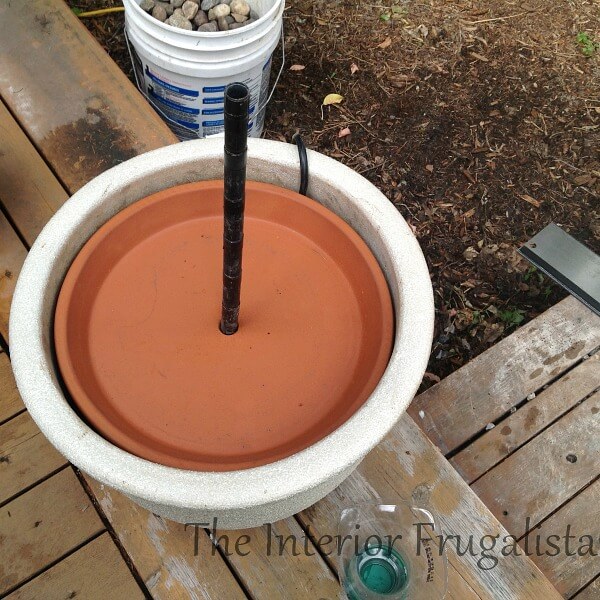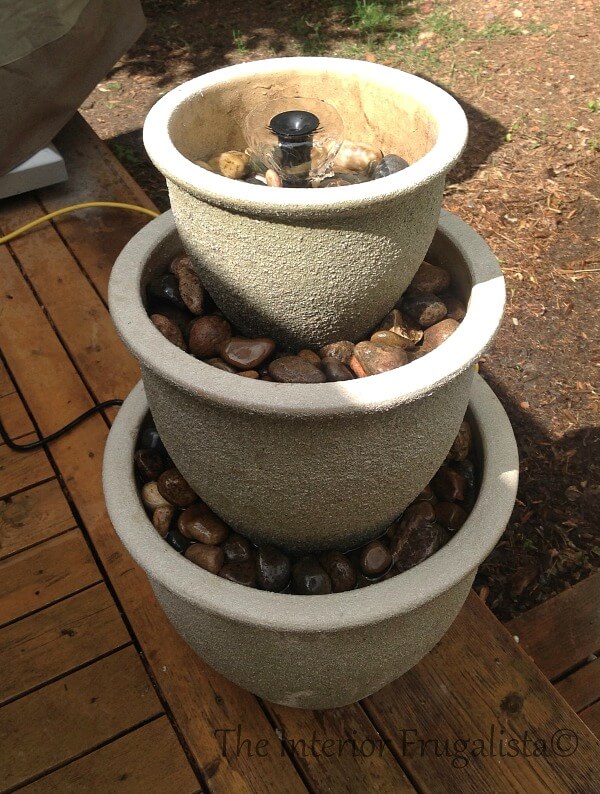How To Turn Plant Pots Into A Water Fountain
This DIY Plant Pot Water Fountain idea is the perfect budget-friendly backyard water feature for a deck, patio, porch, or apartment balcony. If you have extra flower pots you're not using, then turn them into a relaxing water fountain and I'll show you how.
But if you don't have any suitable flower pots and need to buy some, if you wait until the end of the season you can find them on clearance. But if budget isn't an issue, look for a pair or trio of flower pots at varying heights.
DIY Plant Pot Water Fountain
Most pumps come with multiple spray heads so you'll have a few choices for the type of spray you want on yours. Pictured above is the water fountain with two plant pots and a single-tier spray head. Pictured below are three plant pots and a mushroom spray head.
I spent a few days scratching my head trying to figure out how to make this work. I'm not going to lie, there were a few botched attempts and some hiccups along the way.
But eventually, Mr. Frugalista and I figured it out and once we did, it fell into place seamlessly. I'm going to share the process in nine easy to follow steps.
These are the well-used flower pots I used to make our water fountain along with a few bags of river rock.
We also used these tools and supplies.
This post contains affiliate links so you can see what products I used or recommend for this project. As an Amazon Associate, I earn a small commission from qualifying purchases at no extra cost to you.
Water Fountain Supply List
Large Flower Pot Trio with a drainage hole in the bottom to accommodate the pump tubing.2 Terracotta Saucers close to the same diameter as the bottom and middle pots.
PVC pipe large enough to stabilize a pot sitting on top.
Pond Pump (see tip below).
River rocks
Pond Pump Pro-Tip
We used a 100 GPH Pond Pump for our fountain. It is important that the pump can lift the water just above the height of the top flower pot. A good rule of thumb is to get one rated for about six inches higher than what you need. Even better is finding a pump with a flow reducer valve so you can adjust the water flow. But if yours doesn't have one, like ours doesn't, change the nozzle if the water pumps too high.
Before we get into the nitty-gritty of how to make the water fountain, almost all of the DIY projects shared here at Interior Frugalista have step-by-step tutorials so why not get your budget DIY on and subscribe. You can also follow us on Pinterest, Facebook, Instagram, and YouTube.
How To Build A Plant Pot Water Fountain
Before we get into the detailed tutorial, I should mention that we are self-taught DIYers and not trained professionals. This step-by-step tutorial is based on our building knowledge only. However, if you are a do-it-yourselfer like us, you'll find these steps helpful if you plan on making a version of our water fountain.
Step 1 - Seal Flower Pot Drainage Holes
I know I told you earlier to purchase flower pots WITH drainage holes but we're going to have to seal one of them. If your bottom flower pot has a drainage hole, it will need to be sealed in order for the water to recirculate.
To do this use a small tile to plug the hole, secured to the bottom of the pot with silicone. Also, run a bead of silicone all around the tile to ensure a tight seal. Let it cure for at least 24 hours before moving on to the next step.
Step 2 - Insert The Pump
- Based on the type of pump you purchase and the size of the pots, you may have to raise the pump to get the required height. To do this set something sturdy in the center of the bottom pot and set the pump on it. Hopefully, you can avoid this step.
- Attach the plastic extenders on the pump in order to raise it so the spray head is above the rim of the top flower pot.
Step 3 - Plant Pot Risers
- Cut the PVC pipe to a length that will allow the second pot to sit just below the rim of the bottom pot.
- Repeat this step for the second and third pots.
- Now that you have the desired height for each pot, remove the PVC pipe and notch out a groove for the bottom pot to accommodate the water pump's electrical cord (pictured below).
Step 4 - Base For Largest Flower Pot
Set the plastic pipe so it rests inside the largest pot. This becomes the base for the next flower pot. Notice how the base we used to raise the pump fits inside the PVC pipe?
Pro-Tip 1
Cut the PVC pipe perfectly straight so the stacked flower pots sit level.
Step 5 - Base For Middle Flower Pot
- Drill a hole in the center of a terracotta saucer with a ceramic drill bit large enough to accommodate the pump extender.
- Place the largest terracotta saucer through the pump extender and rest it on top of the PVC pipe in the bottom flower pot (pictured below).
Pro-Tip 2
Unlike how we did it in the photo below, it is better to place the terracotta saucer upside down to conceal the edge of the saucer.
Step 6 - Insert Middle Flower Pot
Repeat Step 5 for the next terracotta saucer and insert the PVC pipe into the middle pot.
Step 7 - Base For Top Flower Pot
Add the next size terracotta saucer but remember to place it upside down (unlike shown in the photo below).
Step 8 - Insert Top Flower Pot
- Set the smallest flower pot on top of the terracotta base.
- Ensure your spray head is just above the rim of the top flower pot.
- You may need to add another pump extender to achieve the correct height.
- Insert your choice of spray head onto the last pump extender.
Step 9 - River Rocks And Water
- Place river rocks on each saucer until they are completely hidden.
- If your saucers don't cover the entire pot (like the middle pot in the photo above), use larger river rocks to fill the void.
- Fill the bottom pot with water and plug the water pump in.
- It will take a few seconds for the pump to prime.
- Don't be alarmed by the noise the pump makes during this process.
- Now you're ready to enjoy your new budget-friendly backyard water feature!
Will The Water Run Dry?
The water will evaporate, especially on hot days. It is important that you check the water level in the bottom pot regularly and fill it as necessary
Spray Head Nozzle Styles
The type of spray nozzle you use will determine the way the water fountain is assembled.
Mushroom Spray Head
This is the spray head we used on the three-tier version of our water fountain. The water flows from the bottom pot up the stem and through the spray head. The spray looks like a mushroom cap and the water will not flow over the pots. This style can be dismantled for winter storage.
Single Tier Spray Head
This is the spray head we used on the two-tier version of our water fountain. Much like the mushroom style, the water flows from the bottom pot up the stem and through the spray head. The water doesn't flow over the pots with this style and it can be dismantled for winter storage.
Cascading Spray Head
If you want the look of standing water that cascades over the edges, you will need to silicone around the drainage hole in the middle and top flower pots where the tubing is passed through. By doing this the water will be held in each pot and trickle over the sides. Note with this style the fountain cannot be dismantled for winter storage.
Blossom Spray Head
For this style, you will need a large basin under the bottom flower pot to catch and hold the water so the spray can flow over the edges of the pots and land in the basin below. With this style, your bottom pot will have a hole in it so the water recirculates from the basin rather than the bottom pot. With this style, the basin must be deep enough to hold a sufficient water supply to keep the pump submerged in the bottom pot.
There you have it, a budget-friendly stacked flower pot water fountain for a deck, patio, porch, or apartment balcony.
I also made a Solar Powered Flower Pot Fountain that you may like and it takes less than 15 minutes to build.
But if you're looking for an amazing go big or go home water feature, then check out my very popular DIY Outdoor Water Wall.
This large water feature is a focal point of a backyard oasis and it makes a fabulous deck privacy screen too. But you will need to know your way around power tools to build one.
Thanks for stopping by the Interior Frugalista today! I hope you were inspired by this DIY backyard fountain idea.
If you have any questions, please leave them in the comment section below or the Contact Me tab at the top to drop me an email. I love hearing from you!
If you enjoyed this DIY Flower Pot Fountain, I'd be so thankful if you shared it with a friend and pinned it to your DIY Water Features or Outdoor Living Ideas board on Pinterest.

I share my projects at these inspiring link parties.
















Are you protecting the pump from small stones and debris? Is that why you put it into the pot?
ReplyDeleteI'm not sure I understand the question, Pam. The pump needs to be submerged in water and so the largest plant pot on the bottom houses the pump which must always be filled with water. The pump is sitting in the pvc pipe to hold it upright and to support the saucer that middle plant pot is set on. I hope this answered your question.
DeleteThanks
ReplyDeleteYou're welcome,, Tajmir!
DeleteI'm looking for suitable pots, do they have to be internally glazed
ReplyDeleteAny vessel that holds water will work.
DeleteHello, I have one question... shouldn't I drill holes in the bottom pvc pipe to ensure the water gets to the pump??
ReplyDeleteBecause the pvc pipe is not sealed to the bottom of the pot, the water does fill the cavity for the pump. I hope this helps!
DeleteCould I use two plastic pots with holes on the bottom instead of the pvc pipe? Thanks :)
ReplyDeleteDo you mean placing them inside your larger pots or using the plastic pots as your fountain? If using the plastic pots for the fountain you'll need to plug the bottom pot. If using them inside the larger pots instead of pvc pipe, as long as the water can recirculate to the bottom pot, you're good to go!
ReplyDeleteThis is the first time I have had the pleasure of seeing your posts on making fountains. I am thrilled with what I have seen and you make it seem so easy that I can’t wait to start. I was wondering if you ever do anything with cement and small rocks to create a fountain and if you do what kind of cement would you suggest? Again I absolutely love your post.
ReplyDeleteHi Paula Jo, welcome! So glad you've enjoyed my water feature posts. 😊 I have never made a cement fountain but have DIY concrete garden projects on my Must Try List. If you go into Pinterest, press the magnifying glass icon, and search "cement pond diy water fountains" you will find all kinds of awesome ideas. I hope that helps!
ReplyDeleteCan you use solar powered water pump instead of electrical.
ReplyDeleteAbsolutely! In fact there is a link in this post to one that I made with a solar bird bath style pump. But you could also use a solar water pump that has a separate rechargeable solar panel that sticks in the ground.
DeleteThis is brilliant Thank you
ReplyDeleteYou're welcome! I'm happy to hear you like our DIY water fountain idea.
DeleteI was just wanting to know the best way to winterize the fountain please.
ReplyDeleteThe best way to winterize the fountain is to drain the water from the flower pot and remove the pump and store it indoors. I hope this helps!
DeleteWhere did you get the plastic risers and fountain tops for your pump? Most of them aren't sold with risers. Thank you!
ReplyDeleteOur water pump came with a selection of spray nozzle heads as well as plastic risers. If your pump didn't come with risers then you could probably make one with small PVC pipe (check plumbing aisle at your home improvement store). I hope this helps!
DeleteLoved your design and building prow ice. I would like to make the same 3 pot fountain but with a solar pump. Can you explain the differences>
ReplyDeletePlease scroll to the bottom of this post and you will see I have included links to other water feature tutorials, including a solar powered option.
DeleteHi Marie, what pump did you purchase?
ReplyDeleteOur plant pot water fountain was made several years ago and our specific pump may no longer be available (purchased locally in Canada). I have provided a link to pond pumps in the Water Fountain Supply List above. Please also refer to the Pond Pump Pro Tip paragraph that follows the supply list for guidance when purchasing your pump. Enjoy your water feature!
Delete